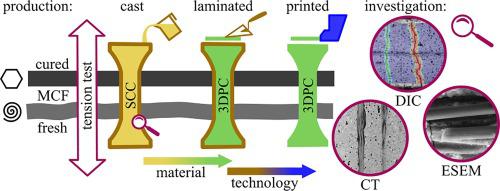当前位置:
X-MOL 学术
›
Mater. Des.
›
论文详情
Our official English website, www.x-mol.net, welcomes your feedback! (Note: you will need to create a separate account there.)
Integrating continuous mineral-impregnated carbon fibers into digital fabrication with concrete
Materials & Design ( IF 8.4 ) Pub Date : 2024-03-03 , DOI: 10.1016/j.matdes.2024.112794 Tobias Neef , Steffen Müller , Viktor Mechtcherine
Materials & Design ( IF 8.4 ) Pub Date : 2024-03-03 , DOI: 10.1016/j.matdes.2024.112794 Tobias Neef , Steffen Müller , Viktor Mechtcherine

|
Digital concrete technologies, such as 3D concrete printing, have the potential to be game changers in the construction industry by reducing material consumption and offering a high level of automation. This not only provides a solution to the shortage of qualified workers but also makes construction sites more attractive workplaces. However, a significant challenge lies in integrating reinforcement, as traditional methods quickly reach their limits, particularly in geometrically complex, material-minimized structures. A potential solution is the use of mineral-impregnated carbon fibers (MCF) reinforcement, which offers high flexibility for 3D printing and better bonding to concrete compared to polymer coating, among other advantages. This article presents the integration of both freshly impregnated and cured MCF into two different concretes in the context of digital fabrication: 3D-printed concrete (3DPC) and self-compacting concrete (SCC). A particular focus was on the mechanical performance of MCF and MCF-reinforced concrete, as well as on the bond behavior between MCF and concrete. The second focus was on the production method. Therefore, samples were conventionally cast with SCC, while layered pouring or printing were used for producing specimens with 3DPC. It was found that the cured MCF exhibited a notably better bond, enhanced by 50%, to both 3DPC and SCC compared to freshly impregnated yarns. Subsequently, when subjected to uniaxial tensile loading, a significantly higher crack density and more uniform crack distribution could be observed in composites with cured MCF using digital image correlation (DIC). This effect was particularly pronounced in printed specimens and confirmed with computed tomography (CT) and environmental scanning electron microscope (ESEM) images.
中文翻译:

将连续矿物浸渍碳纤维集成到混凝土数字化制造中
3D 混凝土打印等数字混凝土技术有可能通过减少材料消耗并提供高水平的自动化来改变建筑行业的游戏规则。这不仅解决了合格工人短缺的问题,而且使建筑工地成为更具吸引力的工作场所。然而,一个重大挑战在于整合加固,因为传统方法很快就达到了极限,特别是在几何复杂、材料最小化的结构中。一个潜在的解决方案是使用矿物浸渍碳纤维 (MCF) 增强材料,它为 3D 打印提供了高灵活性,并且与聚合物涂层相比,它与混凝土的粘合性更好,等等。本文介绍了在数字制造的背景下将新浸渍和固化的 MCF 集成到两种不同的混凝土中:3D 打印混凝土 (3DPC) 和自密实混凝土 (SCC)。特别关注 MCF 和 MCF 增强混凝土的机械性能,以及 MCF 和混凝土之间的粘结行为。第二个焦点是生产方法。因此,样品通常采用SCC铸造,而3DPC则采用分层浇注或打印来制作样品。结果发现,与新浸渍的纱线相比,固化的 MCF 对 3DPC 和 SCC 的粘合力明显更好,增强了 50%。随后,当承受单轴拉伸载荷时,使用数字图像相关 (DIC) 可以在具有固化 MCF 的复合材料中观察到明显更高的裂纹密度和更均匀的裂纹分布。这种效应在打印样本中尤其明显,并通过计算机断层扫描 (CT) 和环境扫描电子显微镜 (ESEM) 图像得到证实。
更新日期:2024-03-03
中文翻译:

将连续矿物浸渍碳纤维集成到混凝土数字化制造中
3D 混凝土打印等数字混凝土技术有可能通过减少材料消耗并提供高水平的自动化来改变建筑行业的游戏规则。这不仅解决了合格工人短缺的问题,而且使建筑工地成为更具吸引力的工作场所。然而,一个重大挑战在于整合加固,因为传统方法很快就达到了极限,特别是在几何复杂、材料最小化的结构中。一个潜在的解决方案是使用矿物浸渍碳纤维 (MCF) 增强材料,它为 3D 打印提供了高灵活性,并且与聚合物涂层相比,它与混凝土的粘合性更好,等等。本文介绍了在数字制造的背景下将新浸渍和固化的 MCF 集成到两种不同的混凝土中:3D 打印混凝土 (3DPC) 和自密实混凝土 (SCC)。特别关注 MCF 和 MCF 增强混凝土的机械性能,以及 MCF 和混凝土之间的粘结行为。第二个焦点是生产方法。因此,样品通常采用SCC铸造,而3DPC则采用分层浇注或打印来制作样品。结果发现,与新浸渍的纱线相比,固化的 MCF 对 3DPC 和 SCC 的粘合力明显更好,增强了 50%。随后,当承受单轴拉伸载荷时,使用数字图像相关 (DIC) 可以在具有固化 MCF 的复合材料中观察到明显更高的裂纹密度和更均匀的裂纹分布。这种效应在打印样本中尤其明显,并通过计算机断层扫描 (CT) 和环境扫描电子显微镜 (ESEM) 图像得到证实。



























 京公网安备 11010802027423号
京公网安备 11010802027423号